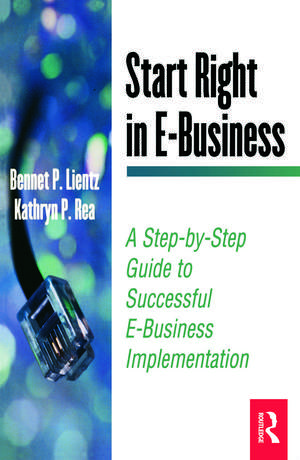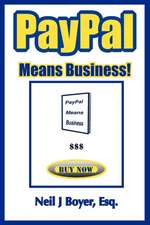Start Right in E-Business
Autor Bennet Lientz, Kathryn Reaen Limba Engleză Paperback – 11 sep 2000
Interest in the evolution ("e-volution") of e-commerce into e-business is a growth field. With the early November announcement that GM and Ford were forming online marketplaces for their suppliers, they placed themselves at the center of new e-business ecosystems that will transform their entire way of doing business. Many firms are increasingly discovering opportunities to move away from simply selling products on the Internet to being able to reinvent their conventional supply chains (as in the auto makers' case) and to being able to offer custom-built products (as Dell Computers does now).
| Toate formatele și edițiile | Preț | Express |
|---|---|---|
| Paperback (1) | 379.53 lei 5-7 săpt. | |
| Taylor & Francis – 11 sep 2000 | 379.53 lei 5-7 săpt. | |
| Hardback (1) | 1014.74 lei 6-8 săpt. | |
| Taylor & Francis – 15 aug 2017 | 1014.74 lei 6-8 săpt. |
Preț: 379.53 lei
Preț vechi: 554.65 lei
-32% Nou
Puncte Express: 569
Preț estimativ în valută:
72.62€ • 76.02$ • 60.45£
72.62€ • 76.02$ • 60.45£
Carte tipărită la comandă
Livrare economică 24 martie-07 aprilie
Preluare comenzi: 021 569.72.76
Specificații
ISBN-13: 9780124499775
ISBN-10: 0124499775
Pagini: 352
Ilustrații: Illustrations
Dimensiuni: 152 x 229 x 17 mm
Greutate: 0.65 kg
Ediția:1
Editura: Taylor & Francis
Colecția Routledge
Locul publicării:Oxford, United Kingdom
ISBN-10: 0124499775
Pagini: 352
Ilustrații: Illustrations
Dimensiuni: 152 x 229 x 17 mm
Greutate: 0.65 kg
Ediția:1
Editura: Taylor & Francis
Colecția Routledge
Locul publicării:Oxford, United Kingdom
Public țintă
Professional Practice & DevelopmentCuprins
Part 1 Get Started in E-Business; Chapter 1 Introduction; Chapter 2 Your E-Business Implementation Roadmap; Part 2 Collect Information on the Business Processes and Technology; Chapter 3 Action 1: Understand Your Business; Chapter 4 Action 2: Select the Activities for E-Business; Chapter 5 Action 3: Assess E-Business Trends and Competition; Chapter 6 Action 4: Set Your Technology Direction for E-Business; Chapter 7 Action 5: Collect Information for E-Business; Part 3 Define How E-Business will Work for You; Chapter 8 Action 6: Analyze Information for E-Business; Chapter 9 Action 7: Define Your New E-Business Transactions and Workflow; Part 4 Prepare for Your E-Business Implementation; Chapter 10 Action 8: Define and Measure E-Business Success; Chapter 11 Action 9: Develop Your E-Business Implementation Strategy; Chapter 12 Action 10: Perform Your E-Business Marketing Activities; Part 5 Implement Your E-Business; Chapter 13 Action 11: Plan Your E-Business Implementation; Chapter 14 Action 12: Execute Your E-Business Implementation; Chapter 15 Action 13: Follow Up after Your E-Business Implementation; Part 6 Address E-Business Issues; Chapter 16 E-Business Implementation and Operations Outsourcing; Chapter 17 Address Specific E-Business Implementation Issues;
Descriere
E-business occurs when a company has established critical business procedures and activities to support e-commerce transactions. Using this definition, e-commerce is part of e-business--a company needs e-commerce to implement e-business. Utilizing e-commerce, however, does not mean that a company has transformed into an e-business. E-business is implemented only when a company changes its internal procedures to take advantage of the e-commerce technologies.
Interest in the evolution ("e-volution") of e-commerce into e-business is a growth field. With the early November announcement that GM and Ford were forming online marketplaces for their suppliers, they placed themselves at the center of new e-business ecosystems that will transform their entire way of doing business. Many firms are increasingly discovering opportunities to move away from simply selling products on the Internet to being able to reinvent their conventional supply chains (as in the auto makers' case) and to being able to offer custom-built products (as Dell Computers does now).
Interest in the evolution ("e-volution") of e-commerce into e-business is a growth field. With the early November announcement that GM and Ford were forming online marketplaces for their suppliers, they placed themselves at the center of new e-business ecosystems that will transform their entire way of doing business. Many firms are increasingly discovering opportunities to move away from simply selling products on the Internet to being able to reinvent their conventional supply chains (as in the auto makers' case) and to being able to offer custom-built products (as Dell Computers does now).



















